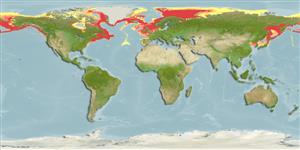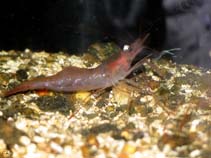Pandalus borealis Krøyer, 1838
Northern shrimp| Native range | All suitable habitat | Point map | Year 2050 |

|
| This map was computer-generated and has not yet been reviewed. |
| Pandalus borealis AquaMaps Data sources: GBIF OBIS |
Классификация / Names народные названия | синонимы | CoL | ITIS | WoRMS
Malacostraca | Decapoda | Pandalidae
Environment: milieu / climate zone / пределы глубины / distribution range экология
донно-пелагический; пределы глубины 9 - 1450 m (ссылка 85480), usually 50 - 500 m (ссылка 85480). Boreal; -2°C - 12°C (ссылка 85480), preferred 4°C (ссылка 107945); 82°N - 35°N, 180°E - 180°E (ссылка 85480)
Distribution страны | регионы FAO | Ecosystems | места находок | интродукции
Circumpolar. Temperate to polar.
Length at first maturity / Size / Weight / Возраст
половая зрелость: Lm 2.4, range 2 - 2.443 cm Max length : 12.0 cm TL самец/пол неопределен; (ссылка 8); 16.5 cm TL (female)
Краткое описание морфология
Life cycle and mating behavior половая зрелость | размножение | нерест | Eggs | Fecundity | Larvae
Основная ссылка
ссылки | координатор | соавторы
Piepenburg, D., N.V. Chernova, C.F. von Dorrien, J. Gutt, A.V. Neyelov, E. Rachor, L. Saldanha and M.K. Schmid 1996 Megabenthic communities in the waters around Svalbard. Polar Biol. 16:431-446. (ссылка 2952)
Статус Красного Списка МСОП
(ссылка 130435: Version 2025-1)
Статус СИТЕС (ссылка 108899)
CMS (ссылка 116361)
Угроза для людей
Использование человеком
рыболовство: коммерческий
FAO - рыболовство: landings, Видовой профиль | FIRMS (Stock assessments) | FishSource | Sea Around Us
инструменты
дополнительная информация
ресурсы в Интернет
BHL | BOLD Systems | CISTI | DiscoverLife | FAO(рыболовство: Видовой профиль; publication : search) | Fishipedia | GenBank (Геном, Нуклеотид) | GloBI | Gomexsi | Google Books | Google Scholar | Google | PubMed | Tree of Life | Wikipedia (Вперёд, поиск) | Zoological Record



